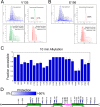Two distinct sites of client protein interaction with the chaperone cpSRP43
- PMID: 29669809
- PMCID: PMC5995501
- DOI: 10.1074/jbc.RA118.002215
Two distinct sites of client protein interaction with the chaperone cpSRP43
Abstract
Integral membrane proteins are prone to aggregation and misfolding in aqueous environments and therefore require binding by molecular chaperones during their biogenesis. Chloroplast signal recognition particle 43 (cpSRP43) is an ATP-independent chaperone required for the biogenesis of the most abundant class of membrane proteins, the light-harvesting chlorophyll a/b-binding proteins (LHCPs). Previous work has shown that cpSRP43 specifically recognizes an L18 loop sequence conserved among LHCP paralogs. However, how cpSRP43 protects the transmembrane domains (TMDs) of LHCP from aggregation was unclear. In this work, alkylation-protection and site-specific cross-linking experiments found that cpSRP43 makes extensive contacts with all the TMDs in LHCP. Site-directed mutagenesis identified a class of cpSRP43 mutants that bind tightly to the L18 sequence but are defective in chaperoning full-length LHCP. These mutations mapped to hydrophobic surfaces on or near the bridging helix and the β-hairpins lining the ankyrin repeat motifs of cpSRP43, suggesting that these regions are potential sites for interaction with the client TMDs. Our results suggest a working model for client protein interactions in this membrane protein chaperone.
Keywords: chaperone; chloroplast; membrane protein; protein targeting; signal recognition particle (SRP).
© 2018 McAvoy et al.
Conflict of interest statement
The authors declare that they have no conflicts of interest with the contents of this article
Figures








Similar articles
-
A Disorder-to-Order Transition Activates an ATP-Independent Membrane Protein Chaperone.J Mol Biol. 2020 Dec 4;432(24):166708. doi: 10.1016/j.jmb.2020.11.007. Epub 2020 Nov 12. J Mol Biol. 2020. PMID: 33188783 Free PMC article.
-
Structural basis for specific substrate recognition by the chloroplast signal recognition particle protein cpSRP43.Science. 2008 Jul 11;321(5886):253-6. doi: 10.1126/science.1158640. Science. 2008. PMID: 18621669
-
Chloroplast SRP43 autonomously protects chlorophyll biosynthesis proteins against heat shock.Nat Plants. 2021 Oct;7(10):1420-1432. doi: 10.1038/s41477-021-00994-y. Epub 2021 Sep 2. Nat Plants. 2021. PMID: 34475529 Free PMC article.
-
Molecular mechanism of SRP-dependent light-harvesting protein transport to the thylakoid membrane in plants.Photosynth Res. 2018 Dec;138(3):303-313. doi: 10.1007/s11120-018-0544-6. Epub 2018 Jun 28. Photosynth Res. 2018. PMID: 29956039 Free PMC article. Review.
-
Component interactions, regulation and mechanisms of chloroplast signal recognition particle-dependent protein transport.Eur J Cell Biol. 2010 Dec;89(12):965-73. doi: 10.1016/j.ejcb.2010.06.020. Epub 2010 Aug 14. Eur J Cell Biol. 2010. PMID: 20709425 Review.
Cited by
-
Switchable client specificity in a dual functional chaperone coordinates light-harvesting complex biogenesis.Sci Adv. 2025 Jun 13;11(24):eadu5791. doi: 10.1126/sciadv.adu5791. Epub 2025 Jun 13. Sci Adv. 2025. PMID: 40512866 Free PMC article.
-
Protein Targeting Into the Thylakoid Membrane Through Different Pathways.Front Physiol. 2022 Jan 12;12:802057. doi: 10.3389/fphys.2021.802057. eCollection 2021. Front Physiol. 2022. PMID: 35095563 Free PMC article. Review.
-
Skd3 (human ClpB) is a potent mitochondrial protein disaggregase that is inactivated by 3-methylglutaconic aciduria-linked mutations.Elife. 2020 Jun 23;9:e55279. doi: 10.7554/eLife.55279. Elife. 2020. PMID: 32573439 Free PMC article.
-
Simultaneous CAS9 editing of cpSRP43, LHCA6, and LHCA7 in Picochlorum celeri lowers chlorophyll levels and improves biomass productivity.Plant Direct. 2023 Sep 12;7(9):e530. doi: 10.1002/pld3.530. eCollection 2023 Sep. Plant Direct. 2023. PMID: 37711644 Free PMC article.
-
A Disorder-to-Order Transition Activates an ATP-Independent Membrane Protein Chaperone.J Mol Biol. 2020 Dec 4;432(24):166708. doi: 10.1016/j.jmb.2020.11.007. Epub 2020 Nov 12. J Mol Biol. 2020. PMID: 33188783 Free PMC article.
References
Publication types
MeSH terms
Substances
Associated data
- Actions
Grants and funding
LinkOut - more resources
Full Text Sources
Other Literature Sources

